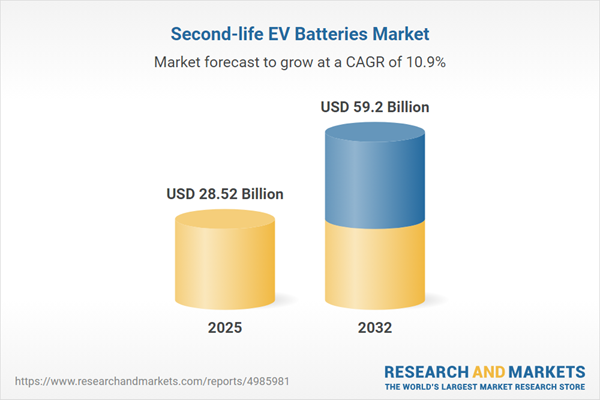Speak directly to the analyst to clarify any post sales queries you may have.
The second-life EV batteries market is rapidly emerging as a strategic pathway for enterprises aiming to optimize energy storage, support sustainability priorities, and maintain regulatory alignment. Senior leaders seeking long-term operational value will find this sector integral to driving adaptable, forward-focused growth.
Market Snapshot: Second-Life EV Batteries Market
The second-life EV batteries market reached USD 25.92 billion in 2024, underlining a measurable rise in enterprise uptake of circular energy models. This momentum is expected to continue, as the market is projected to attain USD 28.52 billion in 2025 and expand robustly to USD 59.20 billion by 2032, supported by a 10.87% CAGR.
Growth is catalyzed by accelerated adoption of electric vehicles, progressive regulatory frameworks, and technological innovation in battery diagnostics and grid modernization. Organizations are strategically evolving procurement models and enhancing supply chain resilience to keep pace with the sector’s transformation, making this market a focal point for emerging investment and operational shifts.Scope & Segmentation: Second-Life EV Batteries Market
A comprehensive understanding of the second-life EV batteries market allows leadership teams to fine-tune strategies, optimize resources, and identify high-impact opportunities across diverse energy storage ecosystems. The market’s segmentation offers actionable pathways for aligning solutions with both regional and sector-specific needs.
- Battery Type: Options include lead-acid, lithium-ion, and nickel-metal hydride batteries, enabling adaptation for commercial operations or infrastructure projects.
- Battery Capacity: Availability of modular and high-capacity units supports custom deployments, addressing the unique scale demands of industries from logistics to heavy machinery.
- Source: Repurposed batteries from commercial fleets, passenger vehicles, buses, heavy equipment, and two-wheelers help organizations target sustainability and reliability within deployment environments.
- Sales Channel: Direct purchasing, distributor partnerships, and online platforms facilitate smooth procurement and integration across value chains.
- Application: Use cases span grid stabilization, telecom and industrial backup, residential and commercial storage, giving buyers practical flexibility for diverse operational scenarios.
- Region: Segments vary across the Americas, Europe, Middle East & Africa, and Asia-Pacific. Each region presents distinct compliance requirements and market dynamics, necessitating region-specific strategies and operational risk management.
- Key Companies: Notable market participants include Connected Energy Ltd., RePurpose Energy Inc., Bayerische Motoren Werke AG, MG Motor, Nunam Technologies India Pvt. Ltd., Toyota Motor Corporation, and Zenobē Energy Limited, supporting value chain efficiency and ongoing innovation.
Key Takeaways for Senior Decision-Makers
- Implementing second-life EV battery solutions can maximize asset utility and enable enterprises to better fulfill their environmental stewardship goals in response to changing compliance demands.
- Adopting advanced diagnostics and modular refurbishment capabilities ensures organizations can tailor projects to operational needs while improving scalability and deployment speed.
- Continuous monitoring of new energy regulations and agile adaptation of internal processes reduces exposure to compliance-related risks, especially across evolving regional markets.
- Digital procurement solutions and energy-as-a-service models help enterprises streamline market entry and develop tailored offerings for varied geographic portfolios.
- Engagement in pilot programs and incentive initiatives allows organizations to phase in second-life battery deployments, balancing operational improvements with risk management during energy transition.
Tariff Impact and Strategic Shifts
Recent U.S. tariffs on imported battery modules have prompted many organizations to revisit their sourcing and supply-chain risk management strategies. This development favors increased investment in domestic refurbishment, greater collaboration with local suppliers, and a need for agile controls to keep operations aligned with changing regulations within the second-life EV batteries sector.
Methodology & Data Sources
This market analysis synthesizes executive interviews, technical evaluations, and current regulatory data. All findings are validated by industry experts to provide reliable, actionable information supporting executive-level planning and decision-making.
Why This Report Matters
- Offers actionable frameworks enabling leadership teams to anticipate and respond to dynamic regulatory and market changes in the energy storage sector.
- Strengthens the foundation for flexible resource planning and minimizes operational disruptions across multiple project environments, from local to global portfolios.
- Empowers organizations to proactively manage procurement and regulatory requirements, safeguarding competitive positioning within the evolving energy landscape.
Conclusion
Senior executives will gain practical guidance for navigating regulatory complexity, securing operational resilience, and leading the energy transition with confidence across the second-life EV batteries market.
Additional Product Information:
- Purchase of this report includes 1 year online access with quarterly updates.
- This report can be updated on request. Please contact our Customer Experience team using the Ask a Question widget on our website.
Table of Contents
3. Executive Summary
4. Market Overview
7. Cumulative Impact of Artificial Intelligence 2025
Companies Mentioned
The companies profiled in this Second-life EV Batteries market report include:- Connected Energy Ltd.
- RePurpose Energy Inc.
- Bayerische Motoren Werke AG
- BeePlanet Factory
- BYD Company Ltd.
- EcarACCU
- Enel X S.r.l.
- Fortum Oyj
- Hyundai Motor Company
- Li-Cycle Corp.
- Mercedes-Benz Group AG
- MG Motor
- Moment Energy Inc.
- Nissan Motor Co., Ltd.
- Nunam Technologies India Pvt. Ltd.
- Nuvation Energy
- Proterra, Inc.
- ReJoule Inc.
- Renault Group
- Rivian Automotive, Inc.
- RWE AG
- Second Life EV Batteries Ltd.
- Toyota Motor Corporation
- Zenobē Energy Limited
Table Information
| Report Attribute | Details |
|---|---|
| No. of Pages | 198 |
| Published | November 2025 |
| Forecast Period | 2025 - 2032 |
| Estimated Market Value ( USD | $ 28.52 Billion |
| Forecasted Market Value ( USD | $ 59.2 Billion |
| Compound Annual Growth Rate | 10.8% |
| Regions Covered | Global |
| No. of Companies Mentioned | 25 |









